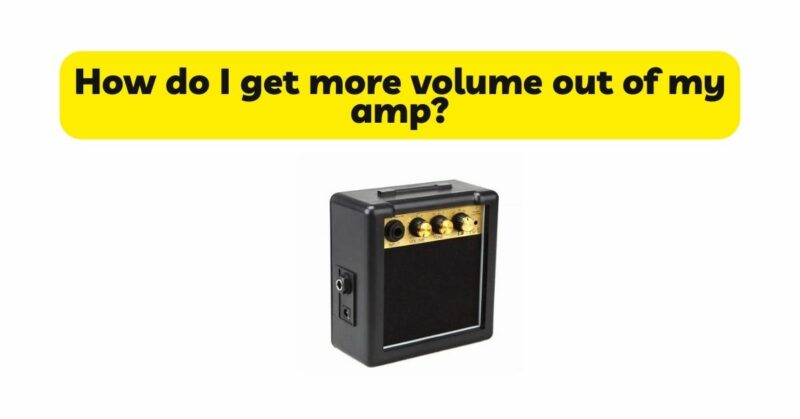As a music enthusiast or a performing musician, you may have found yourself wanting to extract more volume and presence from your amplifier. Whether it’s for practicing at home, jamming with friends, or rocking the stage, maximizing the output of your amp can significantly enhance your sound. In this article, we will explore various techniques and strategies to help you get more volume out of your amplifier, allowing you to unleash its full potential.
- Understand Your Amplifier: Before diving into volume-boosting techniques, it’s crucial to familiarize yourself with the features and capabilities of your amplifier. Take the time to read the user manual, explore the control knobs, and understand the different inputs and outputs. Knowing your amplifier’s specifications will enable you to make informed decisions when applying the following strategies.
- Speaker Efficiency: The efficiency of your speaker plays a vital role in the overall volume output. Speakers with higher efficiency ratings can convert more of the amplifier’s power into acoustic energy, resulting in a louder sound. Consider investing in speakers that are specifically designed for high-volume applications or have higher sensitivity ratings.
- Speaker Placement: Optimizing the placement of your speakers can make a noticeable difference in volume and sound projection. Experiment with speaker positioning by placing them closer to reflective surfaces, such as walls or corners, to utilize natural acoustics and achieve a perceived volume boost. However, be cautious of excessive reflections or standing waves that may introduce unwanted resonances or muddiness.
- Gain Staging: Proper gain staging ensures that each component in your signal chain is operating optimally to maximize volume while maintaining sound quality. Start by setting the gain control on your amplifier to an appropriate level. Adjust it high enough to provide sufficient volume but avoid overdriving the amplifier, which can introduce unwanted distortion.
- Preamp Gain and Volume Control: Most amplifiers feature separate preamp gain and volume controls. Adjusting the preamp gain allows you to increase the input signal’s strength, which leads to a stronger output from the amplifier. However, be cautious not to overdrive the preamp section, as excessive gain can introduce unwanted distortion or clipping. Adjust the volume control to fine-tune the overall output level.
- EQ and Tone Controls: Experimenting with the equalization (EQ) and tone controls on your amplifier can significantly impact the perceived volume. Boosting the midrange frequencies can help cut through the mix and increase the apparent loudness. However, exercise caution to maintain tonal balance and avoid excessive EQ adjustments that may result in an unnatural or harsh sound.
- Effects Loop and Pedals: If your amplifier features an effects loop, consider utilizing it for your effects pedals. Placing time-based effects (such as delay or reverb) in the effects loop can prevent them from affecting the overall gain staging and volume. This allows you to apply effects without compromising the overall output level.
- External Boost or Overdrive Pedals: Integrating a boost or overdrive pedal into your setup can provide an extra push in volume and saturation. These pedals can push your amplifier into its sweet spot, resulting in increased volume and a thicker, more driven tone. Experiment with different pedal settings and gain levels to find the right balance for your desired sound.
- Power Amp Distortion: Certain amplifier designs, such as tube amplifiers, can generate desirable harmonic distortion when pushed to their limits. This can result in a perceived volume increase and a richer, more dynamic sound. Gradually increase the volume on your amplifier’s power amp section while monitoring for the desired level of distortion. Exercise caution not to exceed the amplifier’s capabilities or damage the speakers.
- External Power Amplifier: In situations where you require substantial volume, such as large venues or outdoor performances, adding an external power amplifier to your setup can significantly increase your overall output. By utilizing the additional power and headroom of a dedicated power amp, you can drive your speakers with greater force, resulting in a louder sound.
Conclusion: With these strategies in mind, you can unlock the full potential of your amplifier and achieve higher volume levels without compromising sound quality. Experiment with different techniques, keeping in mind the capabilities and limitations of your specific amplifier. Remember, it’s crucial to strike a balance between volume and maintaining tonal integrity. By understanding your equipment and employing these techniques, you’ll be able to project your sound with confidence and captivate your audience with a powerful sonic presence.


